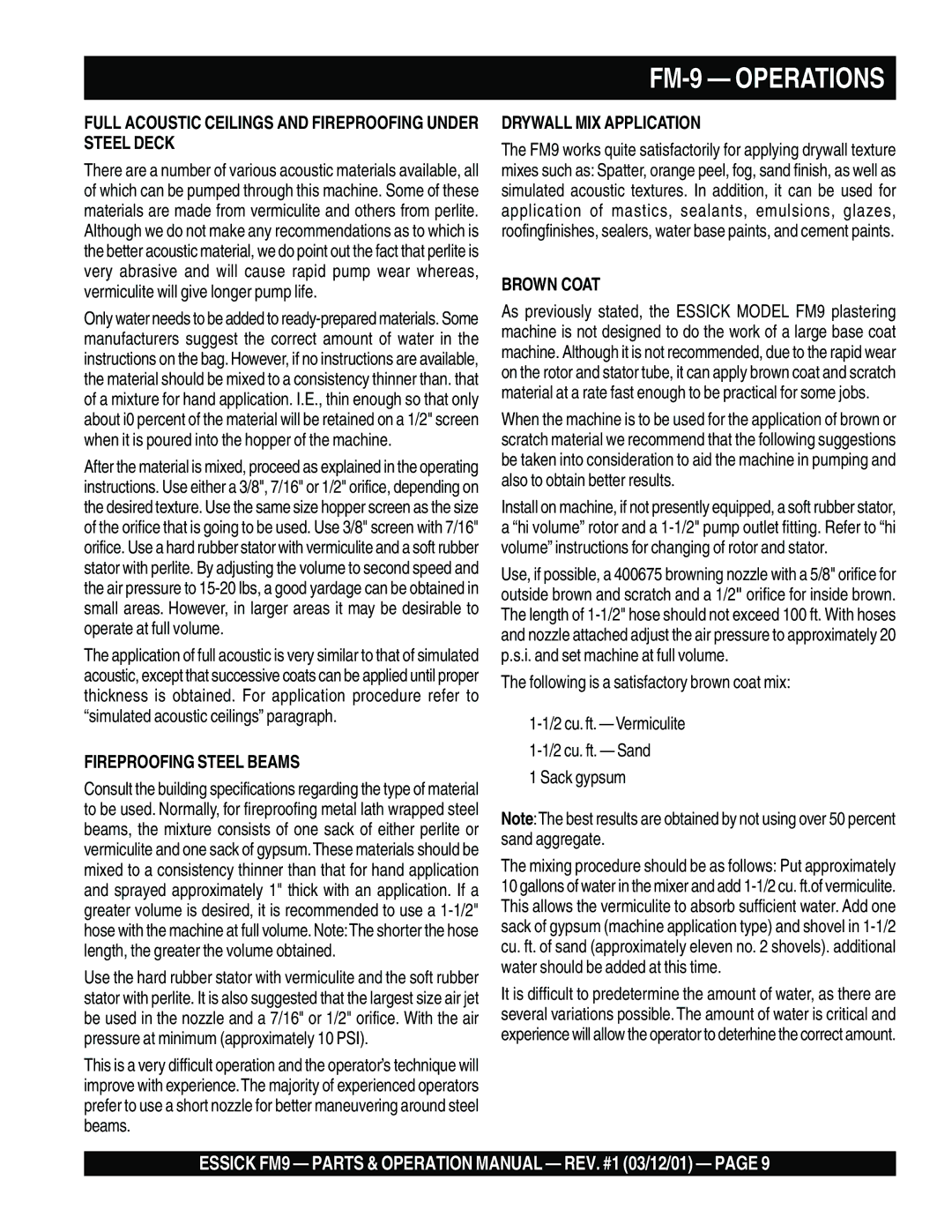
FULL ACOUSTIC CEILINGS AND FIREPROOFING UNDER STEEL DECK
There are a number of various acoustic materials available, all of which can be pumped through this machine. Some of these materials are made from vermiculite and others from perlite. Although we do not make any recommendations as to which is the better acoustic material, we do point out the fact that perlite is very abrasive and will cause rapid pump wear whereas, vermiculite will give longer pump life.
Only water needs to be added to
After the material is mixed, proceed as explained in the operating instructions. Use either a 3/8", 7/16" or 1/2" orifice, depending on the desired texture. Use the same size hopper screen as the size of the orifice that is going to be used. Use 3/8" screen with 7/16" orifice. Use a hard rubber stator with vermiculite and a soft rubber stator with perlite. By adjusting the volume to second speed and the air pressure to
The application of full acoustic is very similar to that of simulated acoustic, except that successive coats can be applied until proper thickness is obtained. For application procedure refer to “simulated acoustic ceilings” paragraph.
FIREPROOFING STEEL BEAMS
Consult the building specifications regarding the type of material to be used. Normally, for fireproofing metal lath wrapped steel beams, the mixture consists of one sack of either perlite or vermiculite and one sack of gypsum.These materials should be mixed to a consistency thinner than that for hand application and sprayed approximately 1" thick with an application. If a greater volume is desired, it is recommended to use a
Use the hard rubber stator with vermiculite and the soft rubber stator with perlite. It is also suggested that the largest size air jet be used in the nozzle and a 7/16" or 1/2" orifice. With the air pressure at minimum (approximately 10 PSI).
This is a very difficult operation and the operator’s technique will improve with experience.The majority of experienced operators prefer to use a short nozzle for better maneuvering around steel beams.
FM-9 — OPERATIONS
DRYWALL MIX APPLICATION
The FM9 works quite satisfactorily for applying drywall texture mixes such as: Spatter, orange peel, fog, sand finish, as well as simulated acoustic textures. In addition, it can be used for application of mastics, sealants, emulsions, glazes, roofingfinishes, sealers, water base paints, and cement paints.
BROWN COAT
As previously stated, the ESSICK MODEL FM9 plastering machine is not designed to do the work of a large base coat machine. Although it is not recommended, due to the rapid wear on the rotor and stator tube, it can apply brown coat and scratch material at a rate fast enough to be practical for some jobs.
When the machine is to be used for the application of brown or scratch material we recommend that the following suggestions be taken into consideration to aid the machine in pumping and also to obtain better results.
Install on machine, if not presently equipped, a soft rubber stator, a “hi volume” rotor and a
Use, if possible, a 400675 browning nozzle with a 5/8" orifice for outside brown and scratch and a 1/2" orifice for inside brown. The length of
The following is a satisfactory brown coat mix:
1 Sack gypsum
Note:The best results are obtained by not using over 50 percent sand aggregate.
The mixing procedure should be as follows: Put approximately 10 gallons of water in the mixer and add
It is difficult to predetermine the amount of water, as there are several variations possible. The amount of water is critical and experience will allow the operator to deterhine the correct amount.
ESSICK FM9 — PARTS & OPERATION MANUAL — REV. #1 (03/12/01) — PAGE 9
